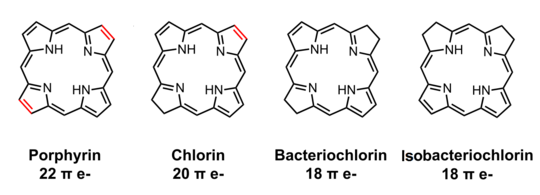Bacteriochlorophyll

Bacteriochlorophylls are photosynthetic pigments that occur in various phototrophic bacteria. They were discovered by C. B. van Niel in 1932. They are related to chlorophylls, which are the primary pigments in plants, algae, and cyanobacteria. Groups that contain bacteriochlorophyll conduct photosynthesis, but do not produce oxygen. They use wavelengths of light not absorbed by plants or Cyanobacteria. Different groups contain different types of bacteriochlorophyll:
| Pigment | Bacterial group | in vivo infrared absorption maximum (nm) |
|---|---|---|
| Bacteriochlorophyll a | Purple bacteria, Heliobacteria, Green Sulfur Bacteria, Chloroflexi, Chloracidobacterium thermophilum[1] | 805, 830-890 |
| Bacteriochlorophyll b | Purple bacteria | 835-850, 1020-1040 |
| Bacteriochlorophyll c | Green sulfur bacteria, Chloroflexi, C. thermophilum | 745-755 |
| Bacteriochlorophyll cs | Chloroflexi | 740 |
| Bacteriochlorophyll d | Green sulfur bacteria | 705-740 |
| Bacteriochlorophyll e | Green sulfur bacteria | 719-726 |
| Bacteriochlorophyll f | Green sulfur bacteria (currently found only through mutation; natural may exist)[2] | 700-710 |
| Bacteriochlorophyll g | Heliobacteria | 670, 788 |
Bacteriochlorophylls a, b, and g are bacteriochlorins, meaning their molecules have a bacteriochlorin macrocycle ring with two reduced pyrrole rings (B and D). Bacteriochlorophylls c, d, e, and f are chlorins, meaning their molecules have a chlorin macrocycle ring with one reduced pyrrole ring (D).

References
- ↑ Bryant DA, et al. (2007-07-27), "Candidatus Chloracidobacterium thermophilum: An Aerobic Phototrophic Acidobacterium", Science, 317 (5837): 523–526, doi:10.1126/science.1143236, PMID 17656724
- ↑ Vogl K, et al. (2012-08-10). "Bacteriochlorophyll f: properties of chlorosomes containing the "forbidden chlorophyll"". Front. Microbiol. 3: article 298, pages 1–12. doi:10.3389/fmicb.2012.00298. PMC 3415949
 . PMID 22908012.
. PMID 22908012.